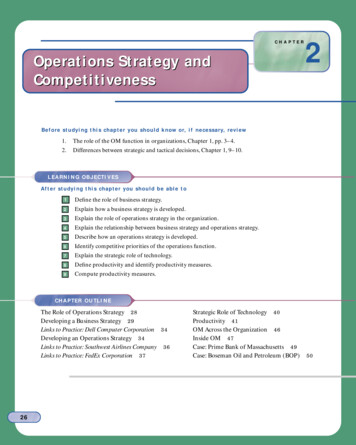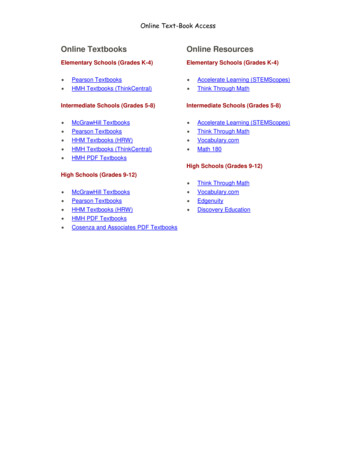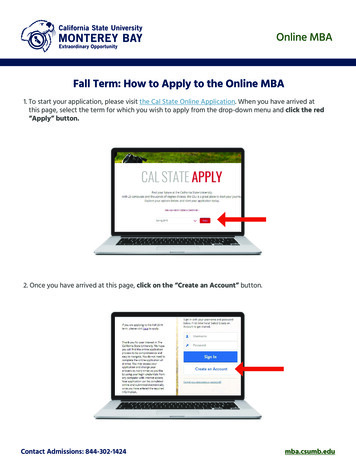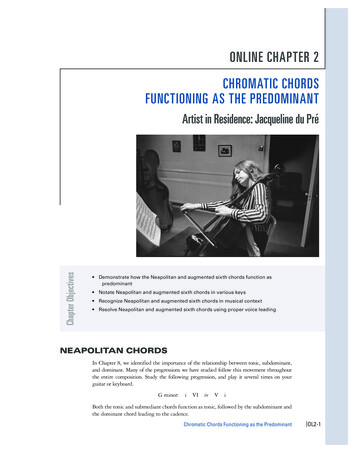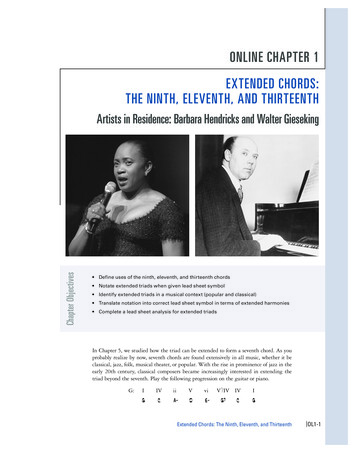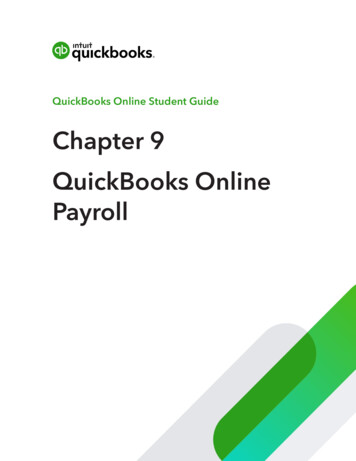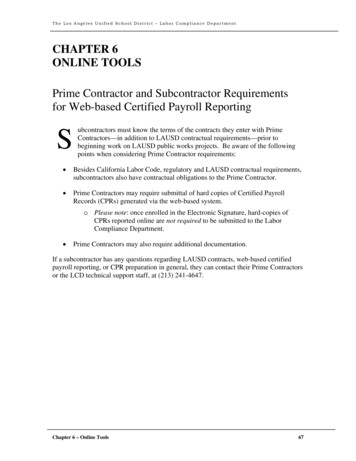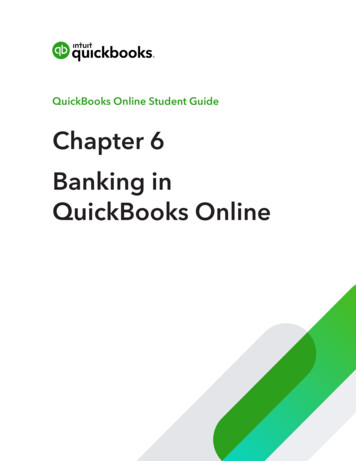
Transcription
STRATEGYChapter 5Core Concepts and Analytical ApproachesPowerPoint Slides“Competitive strategy is about beingdifferent. It means deliberately choosingto perform activities differently or toperform different activities than rivals todeliver a unique mix of value.”—Michael E. PorterProfessor, Harvard Business School Copyright 2014 by Arthur A. Thompson. All rights reserved. Not for distribution.Published and distributed by McGraw Hill Education, Burr Ridge, IllinoisCopyright 2014 by Glo-Bus Software, Inc.Presentation Design –1by Charlie CookCopyright 2014 by Glo-Bus Software, Inc.“The essence of strategy lies in creatingtomorrow’s competitive advantagesfaster than competitors mimic theones you possess today.”“It is much better to make your ownproducts obsolete than allow acompetitor to do it.”—Michael A. Cusamano andRichard W. SelbyCopyright 2014 by Glo-Bus Software, Inc.0–2—Gary Hamel andC. K. Prahalad0–3Copyright 2014 by Glo-Bus Software, Inc.0–4Learning Objectives“Winners in business play roughand don’t apologize for it. Thenicest part of playing hardball iswatching your competitors squirm.”1. Understand what distinguishes each of the five genericcompetitive strategies and the type of competitive advantageeach can produce.2. Gain command of why each of the five competitive strategiesworks better in certain market situations than in others.3. Learn the major avenues for achieving a competitiveadvantage based on lower costs.—George Stalk, Jr. andRob Lachenauer4. Learn the major avenues for achieving a competitiveadvantage based on differentiating a firm’s product or serviceoffering from the offerings of rivals.5. Understand the attributes of a best-cost provider strategy.Copyright 2014 by Glo-Bus Software, Inc.Copyright 2014 GLO-BUS Software, Inc.0–5Copyright 2014 Glo-Bus Software, Inc.5–6Page 1
STRATEGYChapter 5Core Concepts and Analytical ApproachesPowerPoint SlidesChapter 5 RoadmapWhat Does the Term“Competitive Strategy” Refer To?1. The Five Basic Competitive Strategies Competitive strategy deals exclusively with the specificsof management’s game plan for competing successfully:2. Low-Cost Provider Strategies3. Broad Differentiation Strategies4. Focused Low-Cost Strategies5. Focused Differentiation Strategies6. Best-Cost Provider Strategies Actions and approaches to please customers Offensive and defensive moves to counter maneuvers of rivals Responses to shifting market conditions Initiatives to strengthen the firm’s market position and achieve aparticular kind of competitive advantage. Competitive strategy is narrower in scope than businessstrategyCopyright 2014 Glo-Bus Software, Inc.5–7 Two big factors distinguish one firm’s competitive strategy from Managers at different firms have different views on: anotherHow best to deal with competitive pressures and industry drivingforcesWhat future market conditions will be likeWhat strategy specifics makes the most sense for their particularcompany in light of for staking out a market position, competing against rivals, andstriving to deliver superior value to customersIts company’s resource weaknesses and competitive deficienciesIts market opportunities Its vulnerability to external threats Its competitive strengths and weaknesses vis-à-vis rivals The strategic vision, mission, core values, and performance targets thatcompany managers have established FIGURE 5.1Whether a firm’s market target is broad or narrowWhether a firm is pursuing a competitive advantage linked tolower costs or differentiation These two factors give rise to five competitive strategy optionsIts resource strengths and competitive capabilitiesCopyright 2014 Glo-Bus Software, Inc.5–8The Factors that Distinguish OneCompetitive Strategy from AnotherWhy Do Competitive Strategies DifferAmong Firms in the Same Industry? Copyright 2014 Glo-Bus Software, Inc.5–9The Five Basic Competitive Strategy OptionsA low-cost provider strategyA broad differentiation strategyA focused low-cost strategyA focused differentiation strategyA best-cost provider strategyCopyright 2014 Glo-Bus Software, Inc.5–10Low-Cost Provider Strategies A low-cost provider’s strategic target is lower overallcosts than rivals—but not necessarily the lowest possiblecosts. In striving for a low-cost advantage over rivals, it is first necessaryto incorporate features and services that buyers consideressential, then go all out to provide these at a lower cost thanrivals. A product offering that is too frills-free sabotages theattractiveness of the firm’s product even if it is cheaper-priced. Keys to SuccessCopyright 2014 Glo-Bus Software, Inc.Copyright 2014 GLO-BUS Software, Inc.5–11 Having good cost-reduction skills and capabilities Pursuing long-term cost-saving approaches and capabilities thatare difficult for rivals to copy or matchCopyright 2014 Glo-Bus Software, Inc.5–12Page 2
STRATEGYChapter 5Core Concepts and Analytical ApproachesPowerPoint SlidesTranslating a Low-Cost Advantageinto Higher ProfitsCore ConceptA low-cost leader’s basis for competitiveadvantage is lower overall costs thancompetitors. Option 1: Successful low-cost leaders are exceptionallygood at finding ways to drive costs out of theirbusinesses and using their low-cost advantageover rivals to achieve better profitability thanrivals.Copyright 2014 Glo-Bus Software, Inc.Use the lower-cost edge to underprice competitors andattract price-sensitive buyers in great enough numbersto increase total profits Option 2: 5–13The Two Major Avenues forAchieving a Cost AdvantageCharge a price comparable to other low-priced rivals,be content with the resulting sales volume and marketshare, and rely upon the low-cost edge over rivals toearn a bigger profit margin per unit sold, therebyboosting the firm’s total profits and return on investment.Copyright 2014 Glo-Bus Software, Inc.5–14Approach 1: Manage Value Chain ActivitiesVery Cost Efficiently Avenues for performing value chain activities at lower cost than rivals:Approach 1:Be more costefficient thanrivalsApproach 2:Revamp thevalue chainDo a better job than rivals of performingvalue chain activities more cost efficientlyRevamp the firm’s value chain toeliminate costly work steps and/orbypass certain cost-producing valuechain activities altogetherCopyright 2014 Glo-Bus Software, Inc.5–15In Addition: Adopt Strategy Elements That AreEconomical and Lead to Lower Costs ThanRivals Striving to capture all available economies of scale Taking full advantage of experience and learning-curve effects Trying to operate facilities at full capacity Pursuing efforts to boost sales volumes and thus spread outlays for R&D,advertising, and selling and administrative costs out over more units Improving supply chain efficiency Substituting the use of low-cost for high-cost raw materials or component partswhenever there’s little or no sacrifice in product quality or product performance Improving product design and employing cost-saving production techniques Using online systems and sophisticated software to achieve operating efficiencies Pursuing ways to boost labor productivity, reduce workforce size, and otherwise trimcompensation costs Using the company’s bargaining power vis-à-vis suppliers to gain concessions Being alert to the cost advantages of outsourcing and vertical integrationCopyright 2014 Glo-Bus Software, Inc.Approach 2: Revamping the Value Chain Reengineer the value chain to eliminate costly work steps Have lower specifications for purchased materials, parts, andand bypass cost-producing value chain activities:components than rivals Strip frills and features from the company’s product offering that are Sell direct to consumers to cut out the activities and costs ofdistributors and dealers Shift to the use of technologies and/or information systems thatbypass the need to perform certain value chain activities Streamline operations by eliminating low-value-added orunnecessary work steps and activities Have suppliers locate their plants or warehouses close to a firm’sown facilities to reduce materials handling and shipping costsnot highly valued by price-sensitive or bargain-hunting buyers Offer a limited selection or few versions of a product line by deletingslow-selling items and being content to meet the needs of most buyersrather than all buyers Distribute the firm’s product only through low-cost distributionchannels and avoid high-cost distribution channels Use the most economical method for delivering customer orders (evenif it results in longer delivery times)Copyright 2014 Glo-Bus Software, Inc.Copyright 2014 GLO-BUS Software, Inc.5–165–17Copyright 2014 Glo-Bus Software, Inc.5–18Page 3
STRATEGYChapter 5Core Concepts and Analytical ApproachesPowerPoint SlidesNucor Corporation’sLow-Cost Provider StrategyWal-Mart’s Approach to ManagingIts Value Chain Key Elements of Nucor’s StrategyInstitute extensive information sharing with vendors via online systems Pursue global procurement of some items and centralize most purchasing activities Invest in state-of-the-art automation at the company’s distribution centers Strive to optimize the product mix and achieve greater sales turnover Cost Advantages and Bottom-line Results Install security systems and store operating procedures that lower shrinkage rates Negotiate preferred real estate rental and leasing rates with owners of store sites Manage and compensate the workforce in a manner that leads to lower labor costsCopyright 2014 Glo-Bus Software, Inc.5–19Key Characteristics of Southwest Airlines’Low-Cost Provider Strategy Use knowledge about cost-determining factors to streamline orreengineer how activities are performed Engage all company personnel in continuous cost improvement Elimination of several services results in cost savings: In-flight mealsAssigned seatingBaggage transfer to connecting airlinesFirst-class seating and service Use benchmarking to keep close tabs on how the firm’s costscompare with its rivals and other firms performing comparableactivities in other industries Strive to operate with exceptionally small corporate staffs Fast, user-friendly online reservation system: Spend aggressively on resources and capabilities that promiseFacilitates e-ticketingReduces staffing requirements at telephone reservation centers andairport countersCopyright 2014 Glo-Bus Software, Inc.to drive costs out of the business5–21When a Low-Cost Provider StrategyWorks BestCopyright 2014 Glo-Bus Software, Inc. Getting carried away with overly aggressive price cutting to win salescompetitively powerful when:and market share away from rivals Price competition among rival sellers is vigorous The products of rival sellers are essentially identical and supplies arereadily available from several eager suppliers It is hard to achieve product differentiation in ways that buyers value Most buyers use different brands of the product in same ways Buyers incur low costs in switching purchases from one seller to another A big fraction of the industry’s sales are made to large-volume buyerswith significant power to bargain down prices Growing buyer interest in added features or service or a more upscaleproduct Industry newcomers use introductory low prices to attract buyers andbuild a customer base Declining buyer sensitivity to price New developments that alter how buyers use the productCopyright 2014 GLO-BUS Software, Inc.5–22Pitfalls to Avoid in Pursuing aLow-Cost Provider Strategy A low-cost provider strategy becomes increasingly appealing andCopyright 2014 Glo-Bus Software, Inc.5–20cause costs to be high or lowPlanes to fly more hours per dayMore flights to be scheduled per day with fewer aircraftMore revenue to be generated per plane on average than rivals Copyright 2014 Glo-Bus Software, Inc. Scrutinize each cost-creating activity to determine what factors(25 minutes versus 45 minutes for rivals) allows: Lower capital investment and operating costsAbility to charge lower prices than traditional steel companiesusing make-it-from-scratch technologyConsistently good profitability in an industry where profits haveoften been terribleThe Keys to Being a SuccessfulLow-Cost Provider Mastery of fast turnarounds at boarding gates Use electric arc furnaces to lower investment costs and eliminateexpensive steps in making steel products from scratchUse incentive compensation to achieve high productivityand low labor costs per ton producedLocate plants close to customers to keep shipping costs down Reducing price does not lead to higher total profits unless the incrementalgain in total revenues exceeds the incremental increase in total costs Failing to emphasize cost advantages that can be kept proprietary orthat relegate rivals to playing catch-up The value of a cost advantage depends on achieving cost savings thatare hard for rivals to copy or otherwise overcome Becoming too fixated on reducing costs and ignoring:5–23Copyright 2014 Glo-Bus Software, Inc.5–24Page 4
STRATEGYChapter 5Core Concepts and Analytical ApproachesPowerPoint SlidesBeware of Charging a PriceThat Is Too LowBroad Differentiation Strategies Reducing price does not lead to higher total Broad Differentiation Strategiesprofits unless the incremental gain in totalrevenues exceeds the incremental increase intotal costs. Low price, by itself, is not always appealing to Entail offering unique product attributes that a wide range ofbuyers find appealing, valuable, and worth paying for Are attractive when buyer needs and preferences are too diverseto be fully satisfied by a single, standardized product offering Keys to Successbuyers—a low-cost provider’s product offeringmust always contain enough attributes to beattractive to prospective buyers. Will appeal to a broad range of buyers Will be different enough to stand apart from rival product offerings Copyright 2014 Glo-Bus Software, Inc.5–25The essence of a broad differentiation strategyis to offer uniq
1. Understand what distinguishes each of the five generic competitive strategies and the type of competitive advantage each can produce. 2. Gain command of why each of the five competitive strategies works better in certain market situations than in others. 3. Learn the major avenues for achieving a competitive advantage based on lower costs. 4 .
